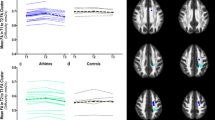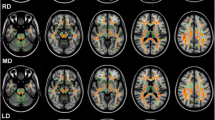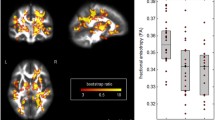Abstract
Microstructural neuropathology occurs in the corpus callosum (CC) after repetitive sports concussion in boxers and can be dose-dependent. However, the specificity and relation of CC changes to boxing exposure extent and post-career psychiatric and neuropsychological outcomes are largely unknown. Using deterministic diffusion tensor imaging (DTI) techniques, boxers and demographically-matched, noncontact sport athletes were compared to address literature gaps. Ten boxers and 9 comparison athletes between 26 and 59 years old (M = 44.63, SD = 9.24) completed neuropsychological testing and MRI. Quantitative DTI metrics were estimated for CC subregions. Group×Region interaction effects were observed on fractional anisotropy (FA; η2p ≥ .21). Follow-up indicated large effects of group (η2p ≥ .26) on splenium FA (boxers<comparisons) and genu mean diffusivity (MD; boxers>comparisons), but not radial diffusivity (RD). The group of boxers had moderately elevated number of psychiatric symptoms and reduced neuropsychological scores relative to the comparison group. In boxers, years sparring, professional bouts, and knockout history correlated strongly (r > |.40|) with DTI metrics and fine motor dexterity. In the comparison group, splenium FA correlated positively with psychiatric symptoms. In the boxer group, neuropsychological scores correlated with DTI metrics in all CC subregions. Results suggested relative vulnerability of the splenium and, to a lesser extent, the genu to chronic, repetitive head injury from boxing. Dose-dependent associations of professional boxing history extent with DTI white matter structure indices as well as fine motor dexterity were supported. Results indicated that symptoms of depression and executive dysfunction may provide the strongest indicators of global CC disruption from boxing.




Similar content being viewed by others
References
Areza-Fegyveres, R., Rosemberg, S., Castro, R. M. R. P. S., Porto, C. S., Bahia, V. S., Caramelli, P., & Nitrini, R. (2007). Dementia pugilistica with clinical features of Alzheimer’s disease. Arquivos de Neuro-Psiquiatria, 65(3B), 830–833.
Banks, S. J., Mayer, B., Obuchowski, N., Shin, W., Lowe, M., Phillips, M., et al. (2014). Impulsiveness in professional fighters. The Journal of Neuropsychiatry and Clinical Neurosciences, 26(1), 44–50. https://doi.org/10.1176/appi.neuropsych.12070185.
Beck, A. T., Epstein, N., Brown, G., & Steer, R. A. (1988). An inventory for measuring clinical anxiety: Psychometric properties. Journal of Consulting and Clinical Psychology, 56(6), 893–897.
Belanger, H. G., Spiegel, E., & Vanderploeg, R. D. (2010). Neuropsychological performance following a history of multiple self-reported concussions: A meta-analysis. Journal of the International Neuropsychological Society, 16(02), 262. https://doi.org/10.1017/S1355617709991287.
Budde, M. D., Janes, L., Gold, E., Turtzo, L. C., & Frank, J. A. (2011). The contribution of gliosis to diffusion tensor anisotropy and tractography following traumatic brain injury: Validation in the rat using Fourier analysis of stained tissue sections. Brain, 134(8), 2248–2260. https://doi.org/10.1093/brain/awr161.
Chappell, M. H., Uluğ, A. M., Zhang, L., Heitger, M. H., Jordan, B. D., Zimmerman, R. D., & Watts, R. (2006). Distribution of microstructural damage in the brains of professional boxers: A diffusion MRI study. Journal of Magnetic Resonance Imaging, 24(3), 537–542. https://doi.org/10.1002/jmri.20656.
Chepuri, N. B., Yen, Y.-F., Burdette, J. H., Li, H., Moody, D. M., & Maldjian, J. A. (2002). Diffusion anisotropy in the corpus callosum. AJNR. American Journal of Neuroradiology, 23(5), 803–808.
Cohen, J. (1988). Statistical power analysis for the behavioral sciences (2nd ed.). Hillsdale: L. Erlbaum Associates.
Corsellis, J. A., Bruton, C. J., & Freeman-Browne, D. (1973). The aftermath of boxing. Psychological Medicine, 3(3), 270–303.
Davenport, E. M., Whitlow, C. T., Urban, J. E., Espeland, M. A., Jung, Y., Rosenbaum, D. A., et al. (2014). Abnormal white matter integrity related to head impact exposure in a season of high school varsity football. Journal of Neurotrauma, 31(19), 1617–1624. https://doi.org/10.1089/neu.2013.3233.
DeKosky, S. T., Blennow, K., Ikonomovic, M. D., & Gandy, S. (2013). Acute and chronic traumatic encephalopathies: Pathogenesis and biomarkers. Nature Reviews Neurology, 9(4), 192–200. https://doi.org/10.1038/nrneurol.2013.36.
Di Russo, F., & Spinelli, D. (2010). Sport is not always healthy: Executive brain dysfunction in professional boxers. Psychophysiology, 47(3), 425–434. https://doi.org/10.1111/j.1469-8986.2009.00950.x.
Heilbronner, R. L., Bush, S. S., Ravdin, L. D., Barth, J. T., Iverson, G. L., Ruff, R. M., et al. (2009). Neuropsychological consequences of boxing and recommendations to improve safety: A National Academy of Neuropsychology education paper. Archives of Clinical Neuropsychology, 24(1), 11–19. https://doi.org/10.1093/arclin/acp005.
Herweh, C., Hess, K., Meyding-Lamadé, U., Bartsch, A. J., Stippich, C., Jost, J., et al. (2016). Reduced white matter integrity in amateur boxers. Neuroradiology, 58(9), 911–920. https://doi.org/10.1007/s00234-016-1705-y.
Jordan, B. D. (2000). Chronic traumatic brain injury associated with boxing. Seminars in Neurology, 20(02), 179–186. https://doi.org/10.1055/s-2000-9826.
Jordan, B. D., Jahre, C., Hauser, W. A., Zimmerman, R. D., Zarrelli, M., Lipsitz, E. C., et al. (1992). CT of 338 active professional boxers. Radiology, 185(2), 509–512. https://doi.org/10.1148/radiology.185.2.1410364.
Klove, H. (1963). CLINICAL NEUROPSYCHOLOGY. The Medical Clinics of North America, 47, 1647–1658.
Knyazeva, M. G. (2013). Splenium of Corpus callosum: Patterns of interhemispheric interaction in children and adults. Neural Plasticity, 2013, 1–12. https://doi.org/10.1155/2013/639430.
Koerte, I. K., Lin, A. P., Willems, A., Muehlmann, M., Hufschmidt, J., Coleman, M. J., et al. (2015). A review of neuroimaging findings in repetitive brain trauma: Neuroimaging findings in repetitive brain trauma. Brain Pathology, 25(3), 318–349. https://doi.org/10.1111/bpa.12249.
Koh, J. O., Cassidy, J. D., & Watkinson, E. J. (2003). Incidence of concussion in contact sports: A systematic review of the evidence. Brain Injury, 17(10), 901–917. https://doi.org/10.1080/0269905031000088869.
Lafayette Instruments. (1989). In ) (Ed.), Grooved pegboard test user instructions. Lafayette: Lafayette Instrument Company, Inc.
Levin, H. S., Lippold, S. C., Goldman, A., Handel, S., High, W. M., Eisenberg, H. M., & Zelitt, D. (1987). Neurobehavioral functioning and magnetic resonance imaging findings in young boxers. Journal of Neurosurgery, 67(5), 657–667. https://doi.org/10.3171/jns.1987.67.5.0657.
Levin, H. S., Wilde, E. A., Chu, Z., Yallampalli, R., Hanten, G. R., Li, X., et al. (2008). Diffusion tensor imaging in relation to cognitive and functional outcome of traumatic brain injury in children. Journal of Head Trauma Rehabilitation, 23(4), 197–208. https://doi.org/10.1097/01.HTR.0000327252.54128.7c.
Lewinsohn, P. M., Seeley, J. R., Roberts, R. E., & Allen, N. B. (1997). Center for Epidemiologic Studies Depression Scale (CES-D) as a screening instrument for depression among community-residing older adults. Psychology and Aging, 12(2), 277–287.
Lischke, A., Domin, M., Freyberger, H. J., Grabe, H. J., Mentel, R., Bernheim, D., & Lotze, M. (2017). Structural alterations in the Corpus callosum are associated with suicidal behavior in women with borderline personality disorder. Frontiers in Human Neuroscience, 11. https://doi.org/10.3389/fnhum.2017.00196.
Marco, E. J., Harrell, K. M., Brown, W. S., Hill, S. S., Jeremy, R. J., Kramer, J. H., et al. (2012). Processing speed delays contribute to executive function deficits in individuals with agenesis of the Corpus callosum. Journal of the International Neuropsychological Society, 18(03), 521–529. https://doi.org/10.1017/S1355617712000045.
McAllister, T. W., Ford, J. C., Flashman, L. A., Maerlender, A., Greenwald, R. M., Beckwith, J. G., et al. (2014). Effect of head impacts on diffusivity measures in a cohort of collegiate contact sport athletes. Neurology, 82(1), 63–69. https://doi.org/10.1212/01.wnl.0000438220.16190.42.
McKee, A. C., Cantu, R. C., Nowinski, C. J., Hedley-Whyte, E. T., Gavett, B. E., Budson, A. E., et al. (2009). Chronic traumatic encephalopathy in athletes: Progressive Tauopathy after repetitive head injury. Journal of Neuropathology & Experimental Neurology, 68(7), 709–735. https://doi.org/10.1097/NEN.0b013e3181a9d503.
McKee, A. C., Stein, T. D., Kiernan, P. T., & Alvarez, V. E. (2015). The neuropathology of chronic traumatic encephalopathy: CTE neuropathology. Brain Pathology, 25(3), 350–364. https://doi.org/10.1111/bpa.12248.
Mouzon, B., Chaytow, H., Crynen, G., Bachmeier, C., Stewart, J., Mullan, M., et al. (2012). Repetitive mild traumatic brain injury in a mouse model produces learning and memory deficits accompanied by histological changes. Journal of Neurotrauma, 29(18), 2761–2773. https://doi.org/10.1089/neu.2012.2498.
Orrison, W. W., Hanson, E. H., Alamo, T., Watson, D., Sharma, M., Perkins, T. G., & Tandy, R. D. (2009). Traumatic brain injury: A review and high-field MRI findings in 100 unarmed combatants using a literature-based checklist approach. Journal of Neurotrauma, 26(5), 689–701. https://doi.org/10.1089/neu.2008.0636.
Radloff, L. S. (1977). The CES-D scale: A self-report depression scale for research in the general population. Applied Psychological Measurement, 1(3), 385–401. https://doi.org/10.1177/014662167700100306.
Reitan, R. M., & Wolfson, D. (1985). The Halstead–Reitan Neuropsycholgical Test Battery: Therapy and clinical interpretation. Tucson: Neuropsychological Press.
Roberts, G. W., Allsop, D., & Bruton, C. J. (1990). The occult aftermath of boxing. Journal of Neurology, Neurosurgery, and Psychiatry, 53(3), 373–378.
Shah, S., Yallampalli, R., Merkley, T. L., McCauley, S. R., Bigler, E. D., MacLeod, M., et al. (2012). Diffusion tensor imaging and volumetric analysis of the ventral striatum in adults with traumatic brain injury. Brain Injury, 26(3), 201–210. https://doi.org/10.3109/02699052.2012.654591.
Shenton, M. E., Hamoda, H. M., Schneiderman, J. S., Bouix, S., Pasternak, O., Rathi, Y., et al. (2012). A review of magnetic resonance imaging and diffusion tensor imaging findings in mild traumatic brain injury. Brain Imaging and Behavior, 6(2), 137–192. https://doi.org/10.1007/s11682-012-9156-5.
Shin, W., Mahmoud, S. Y., Sakaie, K., Banks, S. J., Lowe, M. J., Phillips, M., et al. (2014). Diffusion measures indicate fight exposure-related damage to cerebral white matter in boxers and mixed martial arts fighters. American Journal of Neuroradiology, 35(2), 285–290. https://doi.org/10.3174/ajnr.A3676.
Smith, D. H., Johnson, V. E., & Stewart, W. (2013). Chronic neuropathologies of single and repetitive TBI: Substrates of dementia? Nature Reviews Neurology, 9(4), 211–221. https://doi.org/10.1038/nrneurol.2013.29.
Sollmann, N., Echlin, P. S., Schultz, V., Viher, P. V., Lyall, A. E., Tripodis, Y., et al. (2018). Sex differences in white matter alterations following repetitive subconcussive head impacts in collegiate ice hockey players. NeuroImage: Clinical, 17, 642–649. https://doi.org/10.1016/j.nicl.2017.11.020.
Song, S.-K., Sun, S.-W., Ju, W.-K., Lin, S.-J., Cross, A. H., & Neufeld, A. H. (2003). Diffusion tensor imaging detects and differentiates axon and myelin degeneration in mouse optic nerve after retinal ischemia. NeuroImage, 20(3), 1714–1722.
Stern, R. A., Daneshvar, D. H., Baugh, C. M., Seichepine, D. R., Montenigro, P. H., Riley, D. O., et al. (2013). Clinical presentation of chronic traumatic encephalopathy. Neurology, 81(13), 1122–1129. https://doi.org/10.1212/WNL.0b013e3182a55f7f.
Stiller, J. W., Yu, S. S., Brenner, L. A., Langenberg, P., Scrofani, P., Pannella, P., et al. (2014). Sparring and neurological function in professional boxers. Frontiers in Public Health, 2. https://doi.org/10.3389/fpubh.2014.00069.
Voineskos, A. N., Rajji, T. K., Lobaugh, N. J., Miranda, D., Shenton, M. E., Kennedy, J. L., et al. (2012). Age-related decline in white matter tract integrity and cognitive performance: A DTI tractography and structural equation modeling study. Neurobiology of Aging, 33(1), 21–34. https://doi.org/10.1016/j.neurobiolaging.2010.02.009.
Wilde, E. A., Chu, Z., Bigler, E. D., Hunter, J. V., Fearing, M. A., Hanten, G., et al. (2006). Diffusion tensor imaging in the corpus callosum in children after moderate to severe traumatic brain injury. Journal of Neurotrauma, 23(10), 1412–1426. https://doi.org/10.1089/neu.2006.23.1412.
Wilde, E. A., McCauley, S. R., Chu, Z., Hunter, J. V., Bigler, E. D., Yallampalli, R., et al. (2009). Diffusion tensor imaging of hemispheric asymmetries in the developing brain. Journal of Clinical and Experimental Neuropsychology, 31(2), 205–218. https://doi.org/10.1080/13803390802098118.
Wilde, E. A., Hunter, J. V., Li, X., Amador, C., Hanten, G., Newsome, M. R., et al. (2016). Chronic effects of boxing: Diffusion tensor imaging and cognitive findings. Journal of Neurotrauma, 33(7), 672–680. https://doi.org/10.1089/neu.2015.4035.
Witelson, S. F., Kigar, D. L., Scamvougeras, A., Kideckel, D. M., Buck, B., Stanchev, P. L., et al. (2008). Corpus callosum anatomy in right-handed homosexual and heterosexual men. Archives of Sexual Behavior, 37(6), 857–863. https://doi.org/10.1007/s10508-007-9276-y.
Xu, L., Nguyen, J. V., Lehar, M., Menon, A., Rha, E., Arena, J., et al. (2016). Repetitive mild traumatic brain injury with impact acceleration in the mouse: Multifocal axonopathy, neuroinflammation, and neurodegeneration in the visual system. Experimental Neurology, 275, 436–449. https://doi.org/10.1016/j.expneurol.2014.11.004.
Yeh, F.-C., Verstynen, T. D., Wang, Y., Fernández-Miranda, J. C., & Tseng, W.-Y. I. (2013). Deterministic diffusion Fiber tracking improved by quantitative anisotropy. PLoS One, 8(11), e80713. https://doi.org/10.1371/journal.pone.0080713.
Zhang, L., Ravdin, L. D., Relkin, N., Zimmerman, R. D., Jordan, B., Lathan, W. E., & Uluğ, A. M. (2003). Increased diffusion in the brain of professional boxers: A preclinical sign of traumatic brain injury? AJNR. American Journal of Neuroradiology, 24(1), 52–57.
Zhang, L., Heier, L. A., Zimmerman, R. D., Jordan, B., & Ulug, A. M. (2006). Diffusion anisotropy changes in the brains of professional boxers. AJNR. American Journal of Neuroradiology, 27(9), 2000–2004.
Acknowledgements
This work was supported by the National Institutes of Health grants 5R21-NS086714 and 5P01-NS056202. The funding sources had no role in the interpretation of data, writing of this paper, or in the decision to submit for publication. The contents of this paper are solely the responsibility of the authors and do not represent the official views of the National Institutes of Health. The authors wish to thank Gary Simmons and Ron Collins for their help with participant recruitment as well as Krista Runge and the Core for Advanced MRI (CAMRI) at Baylor College of Medicine for their assistance in MRI acquisition. We also wish to thank the anonymous reviewers for their helpful comments and suggestions in revising the manuscript.
Author information
Authors and Affiliations
Corresponding author
Ethics declarations
Conflict of interest
None to report.
Additional information
Publisher’s Note
Springer Nature remains neutral with regard to jurisdictional claims in published maps and institutional affiliations.
Rights and permissions
About this article
Cite this article
Ware, A.L., Wilde, E.A., Newsome, M.R. et al. A preliminary investigation of corpus callosum subregion white matter vulnerability and relation to chronic outcome in boxers. Brain Imaging and Behavior 14, 772–786 (2020). https://doi.org/10.1007/s11682-018-0018-7
Published:
Issue Date:
DOI: https://doi.org/10.1007/s11682-018-0018-7




